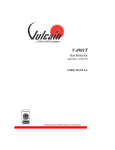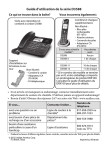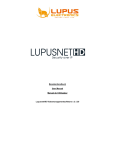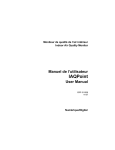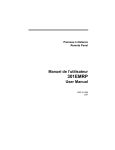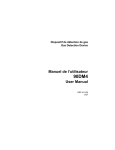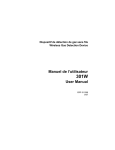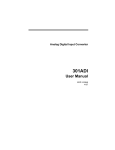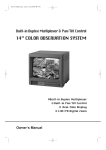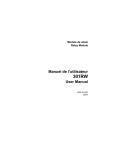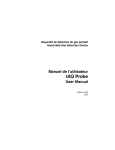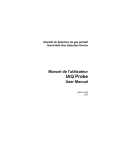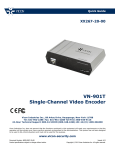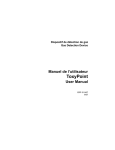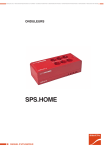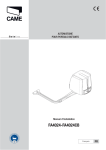Download 901T User Manual
Transcript
Dispositif de détection de gaz Gas Detection Device Manuel de l’utilisateur 901T User Manual ERP 511876 8/07 Gas Detection Device 901T User Manual ERP 511876 8/07 Notices and Trademarks Copyright by Honeywell International Inc. Release 511876 August 2007 While this information is presented in good faith and believed to be accurate, Honeywell disclaims the implied warranties of merchantability for a particular purpose and makes no express warranties except as may be stated in its written agreement with and for its customers. In no event is Honeywell liable to anyone for any indirect, special or consequential damages. The information and specifications in this document are subject to change without notice. Honeywell Analytics 4005 Matte Blvd, Unit G Brossard, Quebec, J4Y 2P4 511876 8/07 901T User Manual Honeywell iii Contacts World Wide Web The following Honeywell Websites may be of interest to our customers: Honeywell Organization Honeywell Analytics Corporate International WWW Address (URL) http://www.honeywellanalytics.com http://www.honeywell.com http://content.honeywell.com/global/ Telephone Contact us by telephone at the numbers listed below: Organization United States and Canada Asia Pacific Europe Latin America Honeywell Analytics Honeywell Asia Pacific Inc. Hong Kong Honeywell Pace Brussels, Belgium Honeywell International Inc. Sunrise, Florida, U.S.A. Phone Number 1-800-563-2967 1-450-619-2450 Fax: 1-888-967-9938 (852) 23 31 9133 [32-2]728-2711 (954) 845-2600 Sales Informations Contact us at [email protected] 511876 8/07 901T User Manual Honeywell v Symbol Definitions The following table lists the symbols used in this document to denote certain conditions: Symbol Definition ATTENTION: Identifies information that requires special consideration TIP: Identifies advice or hints for the user, often in terms of performing a task REFERENCE _ INTERNAL: Identifies an additional source of information within the bookset. CAUTION 511876 8/07 Indicates a situation which, if not avoided, may result in equipment or work (data) on the system being damaged or lost, or may result in the inability to properly operate the process. CAUTION: Indicates a potentially hazardous situation which, if not avoided, may result in minor or moderate injury. It may also be used to alert against unsafe practices. CAUTION: Symbol on the equipment refers the user to the product manual for additional information. The symbol appears next to required information in the manual. WARNING: Indicates a potentially hazardous situation which, if not avoided, could result in serious injury or death. WARNING symbol on the equipment refers the user to the product manual for additional information. The symbol appears next to required information in the manual. 901T User Manual Honeywell vii Contents INTRODUCTION ............................................................11 Unpacking ............................................................................................. 11 Description ............................................................................................ 11 Installation Guidelines ....................................................................... 11 INSTALLATION ..............................................................12 Mounting the Unit .............................................................................. 12 Determining the Number of Transmitters .............................................. 13 Recommended Installation Height ........................................................ 13 Combustible Cross-sensitivity Data ....................................................... 14 Range and Alarm Levels ....................................................................... 14 WIRING DETAILS ..........................................................15 Electrical Wiring ................................................................................. 15 Wiring Requirements ......................................................................... 16 Typical Network Diagram ...................................................................... 16 EOL Network Diagram .......................................................................... 17 USER INTERFACE ........................................................18 Key Functions .................................................................................... 18 Zero Key ................................................................................................ 18 Span Key ............................................................................................... 18 DEVICE COMMUNICATION ..........................................19 Dip Switch Settings ........................................................................... 19 FLN Network Strategies .................................................................... 21 Other Functions ..................................................................................... 21 USE AND CALIBRATION ..............................................32 Points Definitions ............................................................................... 32 Remote Calibration on Modbus Network ........................................... 35 Remote Calibration Steps ..................................................................... 36 511876 8/07 901T User Manual Honeywell ix SPECIFICATIONS .......................................................... 38 Technical Specifications ....................................................................38 Periodic Inspection and Calibration ...................................................39 Maintenance ..........................................................................................39 LIMITED WARRANTY ................................................... 41 Limited Warranty ....................................................................................41 Re-Stocking Policy .................................................................................41 Exclusions ..............................................................................................42 Warranty Limitation and Exclusion .........................................................42 Disclaimer of Unstated Warranties ........................................................43 Limitation of Liability ...............................................................................43 x 901T User Manual Honeywell 511876 8/07 Introduction Installation Guidelines Introduction Unpacking After opening the package and removing the equipment and components, make sure that you have all the items described on the order form or packing slip. Description The 901T Detector is a gas detection device built, sold, and serviced by Vulcain. Vulcain offers a built-in Floor Level Network (FLN) communication driver and point database allowing the detector to coexist on an APOGEE network with other FLN devices. This document describes how the 901T can be accessed through a field panel and how it can be used as a part of a larger control scheme. The 901T can be shipped with one of four sensor types: CO, O2, NO2, and combustibles. Installation Guidelines A Vulcain representative is responsible for proper configuration of the detector for its primary application, while a Siemens Building Technologies representative is responsible for field panel programming, to make use of the detector's functionality in the building automation system. As such, there must be coordination between Vulcain and Siemens Building Technologies representatives to ensure that programming of the 901T is consistent with requirements for field panel programming. • • • • • Make sure to locate the detector and sensing assembly(ies) in an area easily accessible to a technician. Avoid any location where the detector could be subject to vibrations. Avoid any location close to noisy equipment. Avoid any location where temperature changes occur rapidly. Verify all the requirements and existing regulations which may affect the choice of location. 511876 8/07 901T User Manual Honeywell 11 Installation Mounting the Unit Installation Mounting the Unit Installation simply requires the physical mounting of the enclosure (using the mounting holes provided, shown below) and connection of the power and output lines. . Overall width 15.6 cm 6 1/8" 14 cm 5½" Cable shielding (if applicable) Ground connection (if applicable) Conduit 1. Select the desired location 2. Mark the mounting holes (14 cm center to center, as shown) and drill holes. 3. Prepare as required by surface (drywall anchors, etc) 4. Screw the unit into place using appropriate screws 5. Connect power and communication wires (through appropriate conduit) 12 901T User Manual Honeywell 511876 8/07 Installation Mounting the Unit Determining the Number of Transmitters The number of transmitters required is determined by a unit’s operational surveillance radius. Using the table below, the number of units required can be easily evaluated. Surveillance Radius Gas Detected Area Covered CO Carbon monoxide 50 feet (15 m) 7,854 sq. ft. (707 sq. m) O2 Oxygen 23 feet (7 m) 1,257 sq. ft (154 sq. m) NO2 Nitrogen dioxide 50 feet (15 m) 7,854 sq.ft (707 sq. m) Comb Combustible 23 feet (7 m) 1,257 sq. ft (154 sq. m) Recommended Installation Height The installation heights recommended by Honeywell represent general guidelines. Always confirm with local laws and regulations before proceeding, as these take precedence over manufacturer's recommendations. Gas Detected Relative Density (air = 1) Height CO Carbon monoxide 0.968 3 - 5 feet (1 - 1.5m) from floor O2 Oxygen 1.43 3-5 ft (1-1.5m) from floor NO2 Nitrogen dioxide 1.58 (cold) 1-3 ft (30cm - 1m) from ceiling* Comb Most combustibles are heavier than air, with the exception of methane, hydrogen, ethylene and acetylene. For gases that are heavier than air, sensors should be installed approximately 30 cm (1 ft) from the floor. For combustibles that are lighter that air, sensors should be installed 30 cm (1 ft) from the ceiling, close to the potential leak source. *May differ in certain applications: Hot NO2 from exhaust systems is lighter than air. 511876 8/07 901T User Manual Honeywell 13 Installation Mounting the Unit Combustible Cross-sensitivity Data Gas Concentration Acetone Acetylene Cyclohexane Ethylacetate Ethylene Hydrogen Isopropyl alcohol Methane Methylethyl ketone Propane Toluene 20% 20% 20% 20% 20% 20% 20% 20% 20% 20% 20% 901T (Comb) Reading 44.16% 33.3 % 49.84 % 51.26 % 30.74 % 24.66 % 51.64 % 20.00 % 52.62 % 37.66 % 49.40 % Range and Alarm Levels (Factory setting) Detected Gas CO Carbon monoxide O2 Oxygen NO2 Nitrogen dioxide COMB Combustibles 14 Range ALR LO MIN ALR LO MAX ALR HI MIN ALR HI MAX 0-250ppm 20 ppm 25 ppm 180 ppm 200 ppm 0-25.5 % vol 20.0% vol 19.5% vol 21.5% vol 22.0% vol 0-10.2ppm 0.6ppm 0.7ppm 1.0ppm 2.0ppm 0-102% LEL 20.0% LEL 25.0% LEL 45.0% LEL 50.0% LEL 901T User Manual Honeywell 511876 8/07 Wiring Details Electrical Wiring Wiring Details LED SW3 FLN DIP SWITCH MODBUS D6 LOCK Electrical Wiring S S Zero Key B EOL resistor - A COMMUNICATION Span Key POWER V- OUT V+ OUT VV+ This drawing provides an overview of how the 901T circuit board looks when the unit is open. Consult the detailed wiring diagram on the next page for precise diagrams for wiring power and communications. 511876 8/07 901T User Manual Honeywell 15 Wiring Details Wiring Requirements Wiring Requirements Typical Network Diagram MODBUS FLN Communication in S S B - A + V- OUT V+ OUT shield EOL resistor J7 Communication out Power out VV+ J1 A+ B- A+ BV+ V- V+ Power in V- The diagram above illustrates the wiring technique for the 901T in a network setting. J1 Power: Illustrates both incoming and outgoing power connections. J7 Communication: Illustrates both incoming and outgoing communication connections. When wiring one of many units in a network, the wiring runs out from one unit and in to the next unit until the End of Line (EOL) unit is reached. 16 901T User Manual Honeywell 511876 8/07 Wiring Details Wiring Requirements EOL Network Diagram The End of Line, or EOL, wiring of a unit on a network means that there is no other unit connected to the network beyond this point. The unit is, thus, End of Line and there are no further connections to make. Communication in MODBUS FLN 901T EOL resistor S S B shield J7 - A + EOL V- OUT V+ OUT VV+ A+ BV+ V- J1 Power in The unit that is destined to be End-Of-Line is preset at the factory and labeled EOL. Simply remove the jumper from the resistor pins to remove the EOL termination from the unit or place the jumper over the first two resistor pins to make the unit the EOL, as shown in the following drawing. EOL Positions Disabled R RC 511876 8/07 901T User Manual Honeywell 17 User Interface Key Functions User Interface Key Functions The circuit board offer two buttons, or switches, each performing a specific function: Zero Key The zero key provides the unit with the zero reference. This function must be performed without any calibration gas connected. To unlock the function, put switch D7 (lock) in the OFF position (see wiring details). This activates the calibration. By pressing the Zero key, the calibration will be activated and the LED will blink slowly for 15 to 30 seconds. The LED will stop blinking when the calibration is complete. Span Key This function calibrates the sensor span. The calibration gas must be connected to the unit. To unlock the function, put switch D7 (lock) in the OFF position (see wiring details). By pressing the span key, the calibration will be activated and the LED will blink quickly for 1 to 2 minutes. The LED will stop blinking when the calibration is complete. 18 901T User Manual Honeywell 511876 8/07 Device Communication Dip Switch Settings Device Communication This device is a slave device must be integrated into a Floor Level Network, called FLN, with a master (controller, software, etc.). Vulcain devices respond to P1 commands. Dip Switch Settings 8 7 D0 LOCK D6 The detector address is selected (in binary format) with dip switches D6 to D0 (MSB to LSB) on SW3. 6 5 4 3 2 SW3 1 ON The dip switch is labeled 1 through 8. Switch 8 (binary value D7 on the circuit board) is the assigned “LOCK” switch, which locks the Zero and Span keys to prevent accidental activation. Switches labeled 1 through 7 each represent a binary value on the circuit board (D0 to D6). Each of these switches is associated to a value, known as a “weight”, assigned to its ON position (the OFF position has no value), as shown in the table below: Switch Number 1 2 3 4 5 6 7 511876 8/07 Binary PCB number D0 D1 D2 D3 D4 D5 D6 Value 1 2 4 8 16 32 64 901T User Manual Honeywell 19 Device Communication Dip Switch Settings These possible combinations of switch settings allow for up to 128 addresses, as in this example if: Switch D3: ON = 4 Switch D4: ON = 8 Switch D6: ON = 64 Add the values of all the switches that are on to obtain the device’s address (4+8+64=76). If all the switches are in the ON position, the maximum address value would be 127, however, the FLN protocol only supports address values from 1 to 98. Address 99 is reserved for backdoor access (remote calibration, etc.). The detector’s address is updated only at startup, which means that you will have to cut power to the device and power up again. 20 901T User Manual Honeywell 511876 8/07 Device Communication FLN Network Strategies FLN Network Strategies Monitoring Several detector parameters are available for monitoring purposes. These include GAS CONC (Point 4), ALR LO FLAG (Point 90) and ALR HI FLAG (Point 91). These points can be unbundled for monitoring or used in various global control strategies. Monitoring Alarm ALR LO FLAG (Point 90) and ALR HI FLAG (Point LDIs 91). These flags are ON when the gas concentration exceeds alarm levels. For example, these flags can be used to start ventilation or activate a buzzer. Other Functions Set zero CMD SET ZERO (Point 23) is the command used to calibrate the zero of the sensor, which is the reference for the detector when no GAS is present. When ordered, this point will return to STOP by itself and it’s initial value cannot be changed. Note: This command will affect the detector's calibration. Set span CMD SET SPAN (Point 22) is the command used to calibrate the sensor with a specific gas concentration. The concentration applied to the detector is specified in the GAS SPAN (Point 6) field. When ordered, this point will return to STOP by itself and it’s initial value cannot be changed. Note: This command will affect the detector's calibration. 511876 8/07 901T User Manual Honeywell 21 Device Communication FLN Network Strategies Analog Inputs SENSOR TYPE (point 3) shows the gas type detected by the detector, according to the table below: SENSOR TYPE 2 3 5 20 Target Gas CO O2 NO2 COMB Carbon monoxide Oxygen Nitrogen dioxide Combustible gases Other analog inputs include: GAS CONC (point 4) shows the current gas concentration. SENSOR TEMP (point 11) gives the temperature inside the detector. RUN TIME (point 12) is the number of days the sensor has been on. Digital Inputs 22 ALR LO FLAG (Point 90) and ALR HI FLAG (Point 91) are the main physical DIs on the 901T. They correspond to a specific gas concentration limit. the low level, ALR LO FLAG (point 90), is set when the gas concentration reaches the ALR LO MAX level (point 8), and cleared when the gas concentration returns under the ALR LO MIN level (point 7). In the same way, the high level alarm, ALR HI FLAG (point 91) is set when the gas concentration reaches the ALR HI MAX level (point 10) and cleared when the gas concentration is lower than ALR HI MIN (point 9). 901T User Manual Honeywell 511876 8/07 Device Communication FLN Network Strategies Example for Oxygen sensor: Normally, there is 20.9% VOL of oxygen in the air. It is good practice to detect when there is too much oxygen (ALR HI FLAG) and when there is not enough (ALR LO FLAG). The ALR HI FLAG works as described in the previous paragraph. However, for the ALR LO FLAG, the MIN value must be higher that the MAX value for proper use. This instruction tells the detector to use negative trig for this flag (normally used when the alarm level is under the normal concentration). In such a case, the current flag will be set when the oxygen concentration is under the MAX level and is cleared when the concentration rises above the MIN value. Address limitations The default value for CTLR ADDRESS (Point 1) is 99 - the maximum address value allowed in the FLN specifications 511876 8/07 901T User Manual Honeywell 23 LAO LAO LAO LAI LAI LAI 08 09 10 11 12 13 24 LAO LAO LAI 05 07 LAI {04} 06 LAO LAI 03 LAO 01 02 Point Type Point Number ADC FULL RUN TIME SENSOR TEMP ALR HI MAX ALR HI MIN ALR LO MAX ALR LO MIN GAS SPAN FULL SCALE GAS CONC SENSOR TYPE APPLICATION CTRL ADDRESS Subpoint Name 4095 0 0 0 0 0 0 0 0 0 0 2776 99 ADC DAYS DEG F (DEG C) PPM PPM PPM PPM PPM PPM ppm - - - Engr Units 901T User Manual Honeywell Factory Default (SI Units) 1 1 0.18 (0.1) 0.1 0.1 0.1 0.1 0.1 0.1 0.1 1 1 1 Slope (SI Units) 0 0 -40 0 0 0 0 0 0 0 0 0 0 Intercept (SI Units) - - - - - - - - - - - - - On Text - - - - - - - - - - - - - 511876 8/07 Off Text Note: Points not listed are not used in this application. A single value in a column means that the value is the same in English and in SI units. Point numbers that appear in brackets {} may be unbundled at the field panel. Points Database for Nitrogen Dioxide Device Communication FLN Network Strategies LDI LDO LAI 92 {94} {99} 511876 8/07 LDI {91} LDO 23 LDO LDO 22 LDI LAO 20 {90} LAI 14 {29} Point Type Point Number ERROR STATUS RESET FAULT SNS WARM UP ALR HI FLAG ALR LO FLAG DAY.NIGHT CMD SET ZERO CMD SET SPAN OVRD TIME ADC ZERO Subpoint Name 0 - - - - - - - - - ADC Engr Units 901T User Manual Honeywell NORMAL READY NORMAL NORMAL DAY STOP STOP 1 0 Factory Default (SI Units) 1 - - - - - - - 1 1 Slope (SI Units) 0 - - - - - - - 0 0 Intercept (SI Units) - RESET WARMUP START RUN NIGHT START START - - On Text - 25 NORMAL READY NORMAL NORMAL DAY STOP STOP - - Off Text Device Communication FLN Network Strategies LAI LAI LAI LAI 12 13 14 LAO 07 11 LAO 06 LAO LAI 05 10 LAI {04} LAO LAI 03 LAO LAO 02 09 LAO 01 08 Point Type Point Number 511876 8/07 . ADC ZERO ADC FULL RUN TIME SENSOR TEMP ALR HI MAX ALR HI MIN ALR LO MAX ALR LO MIN GAS SPAN FULL SCALE GAS CONC SENSOR TYPE APPLICATION CTRL ADDRESS Subpoint Name 0 4095 0 0 0 0 0 0 0 0 0 0 2777 99 Factory Default (SI Units) 1 1 1 0.18 (0.1) 0.1 0.1 0.1 0.1 0.1 0.1 0.1 1 1 1 Slope (SI Units) 901T User Manual Honeywell ADC ADC DAYS DEG F (DEG C) PCTLEL PCTLEL PCTLEL PCTLEL PCTLEL PCTLEL PCTLEL - - - Engr Units 0 0 0 -40 0 0 0 0 0 0 0 0 0 0 Intercept (SI Units) - - - - - - - - - - - - - - On Text - - - - - - - - - - - - - - Off Text 26 Point Data base for Application Combustibles Note: Points not listed are not used in this application. A single value in a column means that the value is the same in English units and in SI units. Point numbers that appear in brackets { } may be unbundled at the field panel. Device Communication FLN Network Strategies LDI LDI LDI LDO LAI {90} {91} 92 {94} {99} 511876 8/07 LDO LDO LDO 22 {29} LAO 20 23 Point Type Point Number ERROR STATUS RESET FAULT SNS WARM UP ALR HI FLAG ALR LO FLAG DAY.NIGHT CMD SET ZERO CMD SET SPAN OVRD TIME Subpoint Name 0 NORMAL READY NORMAL NORMAL DAY STOP STOP 1 Factory Default (SI Units) 1 - - - - - - - 1 Slope (SI Units) 901T User Manual Honeywell - - - - - - - - - Engr Units 0 - - - - - - - 0 Intercept (SI Units) - RESET WARMUP START RUN NIGHT START START - On Text - NORMAL READY NORMAL NORMAL DAY STOP STOP - Off Text 27 Device Communication FLN Network Strategies LAI LAO LDO 22 LAI 11 20 LAO 10 14 LAO 09 LAI LAO 08 LAI LAO 07 13 LAO 06 12 LAI LAI 03 LAI LAO 02 05 LAO 01 {04} Point Type Point Number 511876 8/07 . CMD SET SPAN OVRD TIME ADC ZERO ADC FULL RUN TIME SENSOR TEMP ALR HI MAX ALR HI MIN ALR LO MAX ALR LO MIN GAS SPAN FULL SCALE GAS CONC SENSOR TYPE APPLICATION CTRL ADDRESS Subpoint Name STOP 1 0 4095 0 0 0 0 0 0 0 0 0 0 2778 99 Factory Default (SI Units) 901T User Manual Honeywell - - ADC ADC DAYS DEG F (DEG C) PCTVOL PCTVOL PCTVOL PCTVOL PCTVOL PCTVOL PCTVOL - - - Engr Units - 1 1 1 1 0.18 (0.1) 0.1 0.1 0.1 0.1 0.1 0.1 0.1 1 1 1 Slope (SI Units) - 0 0 0 0 -40 0 0 0 0 0 0 0 0 0 0 Intercept (SI Units) START - - - - - - - - - - - - - - - On Text STOP - - - - - - - - - - - - - - - Off Text 28 Note: Points not listed are not used in this application. A single value in a column means that the value is the same in English units and in SI units. Point numbers that appear in brackets { } may be unbundled at the field panel. Point Data base for Oxygen Device Communication FLN Network Strategies LDO LDO LDI LDI LDI LDO LAI 23 {29} {90} {91} 92 {94} {99} 511876 8/07 Point Type Point Number ERROR STATUS RESET FAULT SNS WARM UP ALR HI FLAG ALR LO FLAG DAY.NIGHT CMD SET ZERO Subpoint Name 0 NORMAL READY NORMAL NORMAL DAY STOP Factory Default (SI Units) 901T User Manual Honeywell - - - - - - - Engr Units 1 - - - - - - Slope (SI Units) 0 - - - - - - Intercept (SI Units) - RESET WARMUP START RUN NIGHT START On Text - NORMAL READY NORMAL NORMAL DAY STOP Off Text 29 Device Communication FLN Network Strategies LAI LAI LAI LAO LDO 12 13 14 20 22 LAI LAO 07 11 LAO 06 LAO LAI 05 10 LAI {04} LAO LAI 03 LAO LAO 02 09 LAO 01 08 Point Type Point Number 30 . CMD SET SPAN OVRD TIME ADC ZERO ADC FULL RUN TIME SENSOR TEMP ALR HI MAX ALR HI MIN ALR LO MAX ALR LO MIN GAS SPAN FULL SCALE GAS CONC SENSOR TYPE APPLICATION CTRL ADDRESS Subpoint Name STOP 1 0 4095 0 0 0 0 0 0 0 0 0 0 2779 99 Factory Default (SI Units) - - - 1 1 1 1 0.18 (0.1) 1 1 1 1 1 1 1 1 1 1 Slope (SI Units) 901T User Manual Honeywell ADC ADC DAYS DEG F (DEG C) PPM PPM PPM PPM PPM PPM PPM - - - Engr Units - 0 0 0 0 -40 0 0 0 0 0 0 0 0 0 0 Intercept (SI Units) START - - - - - - - - - - - - - - - On Text STOP - - - - - - - - - - - - - - - Off Text 511876 8/07 Note: Points not listed are not used in this application. A single value in a column means that the value is the same in English units and in SI units. Point numbers that appear in brackets {} may be unbundled at the field panel. Point Data base for Carbon monoxide Device Communication FLN Network Strategies LDO LDO LDI LDI LDI LDO LAI 23 {29} {90} {91} 92 {94} {99} 511876 8/07 Point Type Point Number ERROR STATUS RESET FAULT SNS WARM UP ALR HI FLAG ALR LO FLAG DAY.NIGHT CMD SET ZERO Subpoint Name 0 NORMAL READY NORMAL NORMAL DAY STOP Factory Default (SI Units) 1 - - - - - - Slope (SI Units) 901T User Manual Honeywell - - - - - - - Engr Units 0 - - - - - - Intercept (SI Units) - RESET WARMUP START RUN NIGHT START On Text - NORMAL READY NORMAL NORMAL DAY STOP Off Text 31 Device Communication FLN Network Strategies Use and Calibration Points Definitions Use and Calibration Points Definitions Point 01 CTLR ADDRESS This point contains the device address. The default value is 99 (Backdoor address), however, the initial value is set on the hardware (Dip Switch SW3). The detector always answers to adress 99. This point cannot be changed by software (P1 Command) and a reset of the unit is needed to update the value of this register (reset can be d901Tone with a P1 command). Point 02 APPLICATION This point shows the current application number for this product. Point 03 SENSOR TYPE This point shows the gas type detected by the detector. Point 04 GAS CONC The gas concentration can be read with this point. It shows the current gas concentration of its surveillance area. Point 05 FULL SCALE This status point shows the maximum limit (concentration) of the detection range. Point 06 GAS SPAN This point contains the concentration of the gas used for the span calibration. Point 7-10ALARM PNT These points specify alarm levels. Refer to Digital Inputs on page 17 for more detail. Point 11 SENSOR TEMP Shows the temperature inside the detector. 32 901T User Manual Honeywell 511876 8/07 Use and Calibration Points Definitions Point 12 CO RUN TIME This point shows the running time (in days) of the sensor. The point is reset to default value (0) when a 'Factory Reset' is ordered. Point 20 OVRD TIME Used to count the time the device is in 'override' mode. Point 22 CMD SET SPAN This point is used for the span calibration. When this point is ordered (value is 'START'), the device will calibrate its reading with the gas specified in the GAS SPAN point and the concentration read by the detector. When done, the point returns to STOP by itself. Note: This command will affect the detector's calibration. Point 23 CMD SET ZERO This point is used for the zero calibration. When done, the point returns to STOP by itself. Note: Setting this point to STOP, from the START position, will cancel the calibration. Note: This command will affect the detector's calibration. Point 29 DAY.NIGHT This point tells the detector to run in day or night mode. These modes are not supported by the detector. Point 90 - 91ALR LO FLAG and ALR HI FLAG This points shows the status of the corresponding alarm level. Point 92 SNS WARMUP This point shows if the sensor is in warmup mode and returns to “ready” when the sensor has finished the warmup. Avoid calibration during warmup. Note: Not all sensors require a warmup period. 511876 8/07 901T User Manual Honeywell 33 Use and Calibration Points Definitions Point 94 RESET FAULT This point can be used as a LDO for detecting 'not Commanded Reset'. Set the initial value to RESET and set the current value to NORMAL. When a reset appends, this point will toggle to RESET. Point 99 ERROR STATUS This point shows current errors on the detector. See the table below for details Fault: ERROR STATUS (Point 99). This point uses a bit field definition as described below. When the sensor is NOT calibrated, bit B2 is set. B3 is for sensor related error. Ex.: eprom life has expired. Service Alarm bit (B5) will be set after 15 months without calibration. Error Status Point Descriptions Bit B0 B1 B2 B3 B4 B5 B6 B7 34 If Set Read as “0” Read as “0” Sensor not calibrated Sensor error CPU error Service alarm Read as “0” Read as “0” 901T User Manual Honeywell 511876 8/07 Use and Calibration Remote Calibration on Modbus Network Remote Calibration on Modbus Network When using the 901T in a network of sensors, connected to a 301C wireless controller (firmware version 3.0 or higher), it is possible to perform a “remote calibration” using the 301C menu: 6. Using the navigation arrows, access the 301C’s menu 7. Scroll through the menu options and select option 7. Network 8. Scroll through the Network options screens to the last screen and select the Calibration option 7. Network Statistics Calibration The Calibration screen contains four (4) lines of information: Line 1: Line 2: Line 3: Line 4: Indicates the mode (Calib), the device address for calibration and the type of device to calibrate (901T) Indicates the status (Normal or In Calib...) of the specified device Displays the function to perfom (Set Zero) Displays the function to perform (Set Span) and the calibration concentration (246 PPM) Calib 007 901T Status: Normal Set Zero Set Span 246 PPM 511876 8/07 901T User Manual Honeywell 35 Use and Calibration Remote Calibration on Modbus Network Remote Calibration Steps 1. On the first line, scroll to the device address and press Enter 2. Scroll through the devices to display the desired device* and press Enter to select. 3. The second line displays the device’s status 4. Scroll to select the desired function, Set Zero to set the device’s zero 5. Upon selecting Set Zero, the controller requests confirmation. Calib 007 Calibrate Zero? Set Zero Set Span 246 901T PPM 6. Press Enter to confirm or Esc to cancel. If confirmed, the controller sets the 901T’s zero. This takes only a few moments and returns to the default calibration screen. 36 901T User Manual Honeywell 511876 8/07 Use and Calibration Remote Calibration on Modbus Network 7. To set the device Span**, scroll to Set Span and change the calibration value using this procedure: a Using the right arrow, move the cursor to xxx PPM (span value field). Press Enter to select the field. Calib 007 901T Status : In calib... Set Zero Set Span 246 PPM b Use the up or down arrows to increase or decrease the value. c Move the cursor back to Set Span and press Enter to validate the calibration gas value and start the calibration. The device span is being calibrated. The screen will displays the device’s status as “In Calib” until the calibration is complete. * The device must be configured in the 301C’s database in order to be included in the device addresses displayed on screen. **When selecting Set Span, make sure that the device has been exposed to the appropriate calibration gas. Honeywell recommends that this calibration be performed by two people, in radio contact; one person at the controller and one at the actual device. 511876 8/07 901T User Manual Honeywell 37 Specifications Technical Specifications Specifications Technical Specifications Power Requirements: Operating Temperature Range: Operating Humidity Range: Sensing Technologies: Visual Indicators: Communication (length of lines): Recommended conductors: Storage Temperature: Communication: Communication Protocol: Sensor types: Transmission Speed: Dimensions: Weight: 38 17 - 26 Vac, 100 mA @ 24 Vdc -40°F to 122°F (-40°C to 50°C) 0% to 95% RH Non-condensed Q1: electrochemical (toxic) catalytic combustion (combustible) diffusion fuel cell (oxygen) Green LED: Full = Normal operation Slow blink = Zero calibration mode Fast blink = Span calibration mode Up to 2000 feet (600 m) per channel T-tap: 65 feet (20 m) maximum per t-tap 130 feet (40 m) total Twisted & shielded pair 24AWG wires 32°F to 68°F (0°C to 20°C) RS-485 two wires FLN: 4800 Bps, 8 data bits, no parity, 1 stop bit MODBUS RTU: 9600 Bps, 8 data bits, no parity, 1 stop bit CO - Carbon monoxide (application 2779) O2 - Oxygen (application 2778) NO2 - Nitrogen dioxide (application 2776) Combustibles (application 2777) 4800 bps, half duplex, 8 bits of data, 1 stop bit 6.1 x 5 x 2.3 in. (15.25 x 12.5 x 5.75 cm) 1.65 lb. (750 g) 901T User Manual Honeywell 511876 8/07 Specifications Periodic Inspection and Calibration Periodic Inspection and Calibration This unit requires calibration. The calibration frequency will be determined by the operating conditions, which includes extreme temperatures, exposure to contaminants or gas. If the exposure to the gas is greater than the unit’s full scale, the unit must be recalibrated. A calibration inspection must be included as part of a routine maintenance to ensure proper operation of the gas detection unit. CAUTION If the unit’s span or zero cannot be adjusted, the sensor may be approaching its end-of-life and have been contaminated with high concentration of gas, and it must be replaced. Maintenance The 901T will provide years of service with minimal care. Encapsulated electronic plug-in modules are protected from moisture and corrosive environments. • • Visually inspect, test and calibrate with gas at regular intervals to ensure optimum operating condition periods. An accurate maintenance log of all maintenance, calibration and occurences must be kept for the proper service of this product. Note: Do not expose the sensor to high pressure water spray. Sensors should not be exposed to solvents. 511876 8/07 901T User Manual Honeywell 39 Limited Warranty Limited Warranty Limited Warranty Honeywell Analytics, Inc. warrants to the original purchaser and/or ultimate customer ("Purchaser") of Vulcain products ("Product") that if any part thereof proves to be defective in material or workmanship within twelve (12) months, such defective part will be repaired or replaced, free of charge, at Honeywell Analytics' discretion if shipped prepaid to Honeywell Analytics at 4005 Matte Blvd., Unit G, Brossard, Quebec, J4Y 2P4, in a package equal to or in the original container. The Product will be returned freight prepaid and repaired or replaced if it is determined by Honeywell Analytics that the part failed due to defective materials or workmanship. The repair or replacement of any such defective part shall be Honeywell Analytics' sole and exclusive responsibility and liability under this limited warranty. Re-Stocking Policy The following re-stocking fees will apply when customers return products for credit: • 15% re-stocking fee will be applied if the product is returned within 1 month following the shipping date • 30% re-stockingfee will be applied if the product is returned within 3 months following the shipping date A full credit (less re-stocking fee) will only be issued if the product is in perfect working condition. (If repairs are required on the returned product, the cost of these repairs will be deducted from the credit to be issued.) No credits will be issued beyond the three month period. 511876 8/07 901T User Manual Honeywell 41 Limited Warranty Exclusions a.If Gas sensors are part of the Product, the gas sensor is covered by a twelve (12) month limited warranty of the manufacturer. b.If gas sensors are covered by this limited warranty, the gas sensor is subject to inspection by Honeywell Analytics for extended exposure to excessive gas concentrations if a claim by the Purchaser is made under this limited warranty. Should such inspection indicate that the gas sensor has been expended rather than failed prematurely, this limited warranty shall not apply to the Product. c.This limited warranty does not cover consumable items, such as batteries, or items subject to wear or periodic replacement, including lamps, fuses, valves, vanes, sensor elements, cartridges, or filter elements. Warranty Limitation and Exclusion Honeywell Analytics will have no further obligation under this limited warranty. All warranty obligations of Honeywell Analytics are extinguishable if the Product has been subject to abuse, misuse, negligence, or accident or if the Purchaser fails to perform any of the duties set forth in this limited warranty or if the Product has not been operated in accordance with instructions, or if the Product serial number has been removed or altered. 42 901T User Manual Honeywell 511876 8/07 Limited Warranty Disclaimer of Unstated Warranties The warranty printed above is the only warranty applicable to this purchase. All other warranties, express or implied, including, but not limited to, the implied warranties of merchantability or fitness for a particular purpose are hereby disclaimed. Limitation of Liability It is understood and agreed that Honeywell Analytics’ liability, whether in contract, in tort, under any warranty, in negligence or otherwise shall not exceed the amount of the purchase price paid by the purchaser for the product and under no circumstances shall Honeywell Analytics be liable for special, indirect, or consequential damages. The price stated for the product is a consideration limiting honeywell analytics' liability. No action, regardless of form, arising out of the transactions under this warranty may be brought by the purchaser more than one year after the cause of actions has occurred. 511876 8/07 901T User Manual Honeywell 43 Dispositif de détection de gaz 901T Manuel d’utilisateur ERP 511876 8/07 Avis et marques de commerce Tous droits réservés par Honeywell International Inc. Parution 511876 août 2007 Quoique cette information est présentée en bonne foi et est présumée exacte, Honeywell décline la garantie tacite de la qualité marchande pour un emploi particulier et offre aucune garantie exprès, à l’exception des conventions écrites avec et pour ses clients. Honeywell ne sera, sous aucune circonstance, responsable à qui que ce soit pour des dommages spéciaux ou indirectes. Les informations et les spécifications dans ce document sont susceptibles d’être modifiées sans préavis. Honeywell Analytics 4005 Matte Blvd, Local G Brossard, Québec, J4Y 2P4 511876 8/07 Manuel d’utilisateur 901T Honeywell iii Nous joindre Web Les sites Web suivant d’Honeywell peuvent être utilies pour nos clients : Organisation Honeywell Honeywell Analytics Corporate International Adresses WWW (URL) http://www.honeywellanalytics.com http://www.honeywell.com http://content.honeywell.com/global/ Téléphone Utiliser les numéros de téléphone ci-dessous pour nous contacter : Organisation États Unis et Canada Asie Pacifique Europe Amérique latine Honeywell Analytics Honeywell Asia Pacific Inc. Hong Kong Honeywell Pace Bruxelles, Belgique Honeywell International Inc. Sunrise, Floride, É.U. Numéro de téléphone 1-800-563-2967 1-450-619-2450 Fax: 1-888-967-9938 (852) 23 31 9133 [32-2]728-2711 (954) 845-2600 Informations des ventes Nous contacter à [email protected] 511876 8/07 Manuel d’utilisateur 901T Honeywell v Définitions des symboles Le tableau suivant contient la liste des symboles utilisés dans ce document pour indiquer certaine conditions : Symbole Définition ATTENTION: Identifie une information demandant une attention spéciale Truc: Identifie un conseil ou un truc pour l’utilisateur, souvent concernant une tâche RÉFÉRENCE- INTERNE Indique une source d’information supplémentaire à l’intérieur du document. ATTENTION 511876 8/07 Indique une situation à éviter pouvant entraîner des dommages au système ou la perte de travail (documents) ou pouvant prévenir l’opération normale du système. ATTENTION : Indique une situation potentiellement dangereuse qui peut entraîner des blessures mineures ou modérées si pas évité. Peut également signaler des actions dangereuses ATTENTION: Un symbole sur l’équippement qui réfère l’utilisateur à la documentation pour de plus amples informations. Ce symbole apparaît à côté des informations nécessaires dans le manuel. AVERTISSEMENT : Indique une situation potentiellement dangereuse qui peut entraîner des blessures majeures ou la mort si pas évité. AVERTISSEMENT Un symbole sur l’équippement qui réfère l’utilisateur à la documentation pour de plus amples informations. Ce symbole apparaît à côté des informations nécessaires dans le manuel. Manuel d’utilisateur 901T Honeywell vii Table des matières INTRODUCTION ............................................................11 Déballage .............................................................................................. 11 Description ............................................................................................ 11 Directives d’installation ...................................................................... 11 INSTALLATION ..............................................................12 Comment installer l’unité ................................................................... 12 Déterminer le nombre de transmetteurs ............................................ 13 Hauteur d’installation recommandée ..................................................... 13 Facteurs d'interférence des gaz combustibles .................................. 14 DÉTAILS DE CONNEXION ............................................15 Câblage d’alimentation ...................................................................... 15 Exigences de câblage ....................................................................... 16 Diagramme de réseau typique .............................................................. 16 Schéma de fin de ligne de réseau ......................................................... 17 INTERFACE UTILISATEUR ...........................................18 Fonctions des touches ...................................................................... 18 Touche Zero .......................................................................................... 18 Touche Span ......................................................................................... 18 COMMUNICATION .........................................................19 Configuration du commutateur Dip .................................................... 19 Stratégies en réseau fln .................................................................... 21 Fonctions de réseau fln ..................................................................... 22 UTILISATION ET ÉTALONNAGE ..................................33 Définitions de points .......................................................................... 33 Étalonnage à distance sur réseau modbus ....................................... 36 Étapes d’étalonnage .............................................................................. 37 511876 8/07 Manuel d’utilisateur 901T Honeywell ix SPÉCIFICATIONS .......................................................... 39 Spécifications techniques ..................................................................39 Inspection et étalonnage régulier ......................................................40 Entretien .................................................................................................40 GARANTIE LIMITÉE ...................................................... 41 Garantie limitée ......................................................................................41 Politique de Retour ................................................................................41 Exclusions ..............................................................................................42 Limitation et exclusion de la garantie .....................................................42 Dénégation de responsabilité d’autres garanties ...................................43 Limitation de responsabilité ...................................................................43 x Manuel d’utilisateur 901T Honeywell 511876 8/07 Introduction Directives d’installation Introduction Déballage Ouvrir la boîte et sortir les équipements et les composantes. Assurer que tous les objets inclus sont conforme au bon de connaissement. Description Le 901T est un dispositif de détection entièrement conçu, vendu et entretenu par Vulcain. Le 901T peut communiquer soit sur un réseau Modbus RTU ou sur un réseau APOGEE de Siemens. Ce document explique comment accéder à cet unité de par un panneau de contrôle et comment l’unité peut compter parmi un plan de contrôle majeur. Le détecteur 901T peut être configuré avec un de quatre types de sondes, soit : CO, O2, NO2, et combustibles. Directives d’installation Le représentant de Honeywell est responsable de la configuration du détecteur pour son applaication primaire, tandis que le représentant de Siemens Building Technologies est responsable de la programmation du panneau de contrôle, pour intégrer les fonctions de l’appareil au système immotique. Il doit y avoir une coordination avec les deux représentants pour assurer une configuration du 901T conforme aux exigences de la programmation du panneau de contrôlepanneau de contrôle. • • • • • Localiser chaque unité à un endroit facilement accessible pour un technicien. Éviter toute localisation des unités près des sources de bruit électrique et de vibrations. Éviter toute installation près des équipements bruyants. Éviter toute localisation des unités près des sources de température et d’humidité instables. Avant de débuter l’installation, vérifier tous les codes, normes ou législations pouvant affecter les travaux. 511876 8/07 Manuel d’utilisateur 901T Honeywell 11 Installation Comment installer l’unité Installation Comment installer l’unité L’installation requiert seulement le montage physique du boîtier (avec les trous de fixation, selon l’image ci-dessous) et la connexion du câblage d’alimentation et de sorties. Largeur totale 15.6 cm 6 1/8" 14 cm 5½" Blindage de câble (si applicable) Mise à la terre (si applicable) Conduit 1. Choisir l’emplacement désiré 2. Mesurer et marquer les trous de fixation (14 cm de centre à centre) et perçer les trous 3. Préparer pour l’installation selon la surface (ancrages de cloison sèche, etc.) 4. Visser l’unité en place avec les vis appropriées 5. Brancher les fils d’alimentation et de communication (en utilisant un conduit approprié). 12 Manuel d’utilisateur 901T Honeywell 511876 8/07 Installation Déterminer le nombre de transmetteurs Déterminer le nombre de transmetteurs Le nombre de transmetteurs nécessaires dépend du rayon de détection de l’unité. Le tableau ci-dessous permet de facilement évaluer le nombre de transmetteurs nécessaires. Rayon de détection Gaz détecté Surface couverte CO Monoxyde de carbone 15 m (50 pi.) 707 m ca. (7,854 pi.ca)? O2 Oxygène 7 m (23 pi.) 154 m ca. (1,257 pi. ca) NO2 Dioxyde d’azote 15 m (50 pi.) 707 m ca. (7,854 pi.ca) Comb Combustible 7 m (23 pi.) 154 m ca. (1,257 pi. ca) Hauteur d’installation recommandée Les hauteurs d'installation de détecteurs recommandées par Vulcain représentent des directives générales. Toujours vérifier les normes et les lois locales avant de procéder à l'installation. Celles-ci ont préséance sur les recommandations du fabricant. Densité relative (air = 1) Gaz détecté Hauteur CO Monoxyde de carbone 0.968 1 à 1.5 m (3 - 5pi) du sol O2 Oxygène 1.43 1 à 1.5 m (3 - 5pi) du sol NO2 Dioxyde d’azote Comb 30 cm à 1 m (1-3 pi) du plafond* La plupart des combustibles sont plus lourds que l’air, excepté le méthane, l’hydrogène, l’éthylène et l’acétylène. Pour les gaz plus lourd que l’air, des capteurs devraient être installés à environ 30 cm du sol. Pour les combustibles plus légers que l’air, des capteurs devraient être installés à 30 cm du plafond, près de la source potentielle de fuite. 1.58 (froid) *Peut varier dans certaines situations: le NO2 chaud, provenant de systèmes d’aspiration est plus léger que l’air ambiant. 511876 8/07 Manuel d’utilisateur 901T Honeywell 13 Installation Facteurs d'interférence des gaz combustibles Facteurs d'interférence des gaz combustibles La sonde combustible peut réagir à des gaz autres que le gaz ciblé. Le tableau suivant contient la liste de ces gaz avec les résultats de lecture (lors de l’exposition à une concentration de test). Gaz Lecture 901T (Comb) 44.16% 33.3 % 49.84 % 51.26 % 30.74 % 24.66 % 51.64 % 20.00 % 52.62 % 37.66 % 49.40 % Concentration Acétone Acétylène Cyclohexane Ethylacetate Acétate d’éthyle Hydrogène Alcool isopropylique Méthane Méthyléthylcétone Propane Toluène 20% 20% 20% 20% 20% 20% 20% 20% 20% 20% 20% PLAGE ET NIVEAUX D’ALARME (configuration en usine) Gaz détecté Plage CO Monoxyde de carbone 0-250ppm 0-25.5 % vol O2 Oxygène NO2 Dioxyde d’azote 0-10.2ppm COMB Combustibles 14 0-102% LIE ALR LO MIN ALR LO MAX ALR HI MIN ALR HI MAX 20 ppm 25 ppm 180 ppm 200 ppm 20.0% vol 19.5% vol 21.5% vol 22.0% vol 0.6ppm 0.7ppm 1.0ppm 2.0ppm 20.0% LIE 25.0% LIE 45.0% LIE 50.0% LIE Manuel d’utilisateur 901T Honeywell 511876 8/07 Détails de connexion Câblage d’alimentation Détails de connexion D6 LOCK Câblage d’alimentation FLN MODBUS COMMUTATEUR DIP DEL S S Zero Key B - A + EOL cavalier fin de ligne COMMUNICATION Span Key ALIMENTATION V- OUT V+ OUT VV+ Ce dessin offre un aperçu de la carte de circuit imprimé à l’intérieur de l’unité. Consulter les détails de connexion pour connaître les détails de connexion d’alimentation et de communication. 511876 8/07 Manuel d’utilisateur 901T Honeywell 15 Détails de connexion Exigences de câblage Exigences de câblage Diagramme de réseau typique MODBUS FLN Entrée communication S S B - A + shield EOL resistor J7 Sortie communication V- OUT V+ OUT Sortie alimentation VV+ J1 A+ B- A+ BV+ V- Entrée alimentation V+ V- Le dessin ci-haut est une exemple de câblage du 901T dans une configuration réseau. J1 Alimentation : Illustre les connexions d’entrée et de sortie d’alimentation. J7 Communication :Illustre les connexions d’entrée et de sortie de communication. Lors de connexion d’un appareil parmi plusieurs dans un réseau, le câblage passe d’un appareil à l’autre jusqu’à l’appareil de fin de ligne. 16 Manuel d’utilisateur 901T Honeywell 511876 8/07 Détails de connexion Exigences de câblage Schéma de fin de ligne de réseau La connexion fin de ligne, ou EOL, d’un appareil sur un réseau signifie qu’il n’y a aucun autre appareil sur le réseau après celui-ci. Cet appareil est donc la fin de ligne et il ne reste aucune autre connexion à effectuer. MODBUS FLN Entrée communication 901T S S B - A + shield EOL resistor J7 EOL V- OUT V+ OUT VV+ J1 A+ BV+ V- Entrée alimentation L’unité destiné à servir de fin de ligne est préconfiguré et identifié en usine. Simplement retirer le cavalier des broches pour enlever la terminaison fin de ligne ou placer le cavalier sur les deux premières broches pour rendre l’unité un unité de fine de ligne (voir le dessin cidessous. Positions cavalier fin de ligne Désactivé R RC 511876 8/07 Manuel d’utilisateur 901T Honeywell 17 Interface utilisateur Fonctions des touches Interface utilisateur Fonctions des touches La carte de circuit imprimé comporte deux touches, chacune avec une fonction précise : Touche Zero La touche Zero sert de référence du zéro de l’unité. Cette fonction doit être effectuée sans aucun gas d’étalonnage. La fonction doit être déverrouillée en mettant le commutateur DIP D7 (lock) en position OFF (voir les détails de connexion). Ceci démarre l’étalonnage. En appuyant sur la touche Zero, l’étalonnage est démarré et le DEL clignote lentement pendant 15 à 30 secondes. Le DEL arrête de clignoter lorsque l’étalonnage est terminé. Touche Span Cette fonction étalonne le gain (Span) de la sonde. Le gaz d’étalonnage soit être connecté à l’unité. La fonction doit être déverrouillée en mettant le commutateur DIP D7 (lock) en position OFF (voir les détails de connexion). En appuyant sur la touche Span, l’étalonnage est démarré et le DEL clignote rapidement pendant 1 à 2 minutes. Le DEL arrête de clignoter lorsque l’étalonnage est terminé. 18 Manuel d’utilisateur 901T Honeywell 511876 8/07 Communication Configuration du commutateur Dip Communication Cet appareil est un esclave et doit être intégré à un réseau par un maître (centrale, logiciel, etc.). Cet appareil répondent aux commandes P1 du réseau APOGEE de Siemens ou aux commandes Modbus du réseau Modbus RTU. Configuration du commutateur Dip 8 7 D0 LOCK D6 Les commutateurs D6 à D0 (bits poids fort à bits poids faibles) du bloc identifié SW3 permettent de sélectionner l’adresse du détecteur en format binaire. 6 5 4 3 2 SW3 1 ON Le commutateur est numéroté de 1 à 8. Le commutateur numéro 8 (la valeure binare D7 sur la carte de circuit imprimé) est désigné le commutateur de verrouillage (LOCK), ce qui verrouile les touches Span et Zero pour prévenir l’activation fortuit de ces fonctions. Les commutateurs numérotés de 1 à 7 représentent chacun une valeur binaire sur la carte de circuit imprimé (D0 à D6). Chacun de ces commutateurs a une valeur, ou un « poids », associée à la position ON (la position OFF ayant aucune valeur), tel qu’illustré dans le tableau cidessous : Numéro commutateur 1 2 3 4 5 6 7 511876 8/07 Numéro binaire carte circuit D0 D1 D2 D3 D4 D5 D6 Valeur 1 2 4 8 16 32 64 Manuel d’utilisateur 901T Honeywell 19 Communication Configuration du commutateur Dip Ces combinaisons de configuration de commutateurs possibles permettent de configurer jusqu’à 128 adresses, selon cet exemple si : Commutateur D3 : ON = 4 Commutateur D4 : ON = 8 Commutateur D6 : ON = 64 Additionner les valeurs de tous les commutateurs en position « ON » pour obtenir l’adresse de l’appareil (4+8+64=76). Si tous les commutateurs sont en position « ON », la valeur maximale d’adresse serait 127, cependant le protocole FLN ne supporte que les valeurs d’adresses de 1 à 98. L’adresse 99 est réservée pour accès indirect (étalonnage à distance, etc.). L’adresse du détecteur est seulement mise à jour lors du démarrage, donc il est nécessaire de couper l’alimentation puis remettre l’appareil sous tension (c. à d. forcer un démarrage) pour faire la mise à jour de l’adresse. 20 Manuel d’utilisateur 901T Honeywell 511876 8/07 Communication Stratégies en réseau fln Stratégies en réseau fln Monitoring (LDI) d’alarme de détection 511876 8/07 Plusieurs paramètres de détecteur sont disponible aux fins de surveillance. Ceux-ci incluent GAS CONC (Point 4), ALR LO FLAG (Point 90) et ALR HI FLAG (Point 91). Ces points peuvent être dégroupés pour la détection ou utilisés dans de diverses stratégies de contrôle global. ALR LO FLAG (Point 90) et ALR HI FLAG (Point 91). Ces avertisseurs sont en fonction lorsque la concentration de gaz dépasse les niveaux d’alarme. Ces avertisseurs peuvent servir pour démarrer la ventilation ou pour activer les alarmes sonores. Manuel d’utilisateur 901T Honeywell 21 Communication Fonctions de réseau fln Fonctions de réseau fln Set zero CMD SET ZERO (Point 23) est la commande pour étalonner le zéro de la sonde, ce qui est la référence pour le détecteur lorsqu’aucun gaz n’est présent. Ce point revient automatiquement à STOP et sa valeur initiale ne peut être modifiée. Note: Cette commande a un impacte sur l’étalonnage du détecteur. Set span CMD SET SPAN (Point 22) est la commande pour étalonner la sonde avec une concentration précise de gaz. La concentration appliquée sur le détecteur est précisée dans le champs GAS SPAN (Point 6). Ce point revient automatiquement à STOP et sa valeur initiale ne peut être modifiée. Note: Cette commande a un impacte sur l’étalonnage du détecteur. 22 Manuel d’utilisateur 901T Honeywell 511876 8/07 Communication Fonctions de réseau fln Entrées SENSOR TYPE (point 3) indique le type de gaz analogiques détecté par la sonde, selon le tableau suivant : Type de sonde 2 3 5 20 Gaz ciblé CO O2 NO2 COMB Monoxyde de carbone Oxygène Dioxyde d’azote Gaz combustible Autres entrées analogiques : GAS CONC (point 4) indique la concentration de gaz actuelle. SENSOR TEMP (point 11) indique la température à l’intérieur de la sonde. RUN TIME (point 12) indique le nombre de jours depuis la mise sous tension de la sonde. Entrées ALR LO FLAG (Point 90) et ALR HI FLAG (Point 91) sont numériques les principaux DI du 901T. Ces points correspondent à une limite de concentration précise de gaz. Le plus bas niveau, ALR LO FLAG (point 90), est activé lorsque la concentration de gaz atteint le niveau ALR LO MAX (point 8), et désactivé lorsque la concentration retombe sous le niveau ALR LO MIN (point 7). Du même, l’alarme de niveau élevé, ALR HI FLAG (point 91) est activé lorsque la concentration de gaz atteint le niveau ALR HI MAX (point 10) et désactivé lorsque la concentration retombe sous le niveau ALR HI MIN (point 9). 511876 8/07 Manuel d’utilisateur 901T Honeywell 23 Communication Fonctions de réseau fln Exemple pour une sonde d’oxygène : En temps normal, il y a 20.9% VOL d’oxygène dans l’air. Il est recommandé de détecter lorsqu’il y a trop d’oxygène dans l’air (ALR HI FLAG) et lorsque le niveau est insuffisant (ALR LO FLAG). Le ALR HI FLAG fonctionne tel que décrit dans le paragraphe ci-haut. Cependant, il est nécessaire de préciser une valeur MIN plus élevée que la valeur MAX pour assurer le fonctionnement approprié. Ceci donne l’instruction à la sonde d’utiliser le trig négatif pour cet avertissement (générallement utilisé lorsque le niveau d’alarme est plus bas que la concentration normale). Dans un tel cas, l’avertissement sera déclenché lorsque la concentration d’oxygène est en dessous du niveau maximum et sera désactivé lorsque la concentration augmente au delà de la valeur minimum. Limitations La valeur par défaut de CTLR ADDRESS (Point 1) est d’adresses 99 - la valeur maximale des adresses permise dans les spécifications FLN. 24 Manuel d’utilisateur 901T Honeywell 511876 8/07 Type de point LAO LAO LAI LAI LAI LAO LAO LAO LAO LAO LAI LAI LAI LAI Numéro de point 01 02 03 {04} 05 06 07 08 09 10 11 12 13 14 511876 8/07 . ADC ZERO ADC FULL RUN TIME SENSOR TEMP ALR HI MAX ALR HI MIN ALR LO MAX ALR LO MIN GAS SPAN FULL SCALE GAS CONC SENSOR TYPE APPLICATION CTRL ADDRESS Nom du sous point 0 4095 0 0 0 0 0 0 0 0 0 0 2776 99 - ADC ADC DAYS DEG F (DEG C) PPM PPM PPM PPM PPM PPM ppm - - Unités Engr 1 1 1 0.18 (0.1) 0.1 0.1 0.1 0.1 0.1 0.1 0.1 1 1 1 Slope (Unités SI ) Manuel d’utilisateur 901T Honeywell Défaul d’usine (Unités SI) 0 0 0 0 -40 0 0 0 0 0 0 0 0 0 Intercept (Unités SI ) - - - - - - - - - - - - - - On Text - - - - - - - - - - - - - - Off Text 25 Base de données de points pour le dioxyde d’azote Note: Points non inclus ne sont pas utilisés dans cette application. Une seule valeur dans une colonne signifie que la valeur est identique en mesures anglaises et en unités SI. Les numéros de points en parenthèses { } peuvent être dégroupés au panneau de contrôle. Communication Fonctions de réseau fln LDO LDO LDI LDI LDI LDO LAI 22 23 {29} {90} {91} 92 {94} {99} 511876 8/07 LAO LDO 20 Type de point Numéro de point ERROR STATUS RESET FAULT SNS WARM UP ALR HI FLAG ALR LO FLAG DAY.NIGHT CMD SET ZERO CMD SET SPAN OVRD TIME Nom du sous point 0 NORMAL READY NORMAL NORMAL DAY STOP STOP 1 - - - - - - - - - Unités Engr 1 - - - - - - - 1 Slope (Unités SI ) Manuel d’utilisateur 901T Honeywell Défaul d’usine (Unités SI) 0 - - - - - - - 0 Intercept (Unités SI ) - RESET WARMUP START RUN NIGHT START START - On Text - NORMAL READY NORMAL NORMAL DAY STOP STOP - Off Text 26 Communication Fonctions de réseau fln LAI LAO LDO 20 22 LAO 09 14 LAO 08 LAI LAO 07 LAI LAO 06 13 LAI 05 12 LAI {04} LAO LAI 03 LAI LAO 02 11 LAO 01 10 Type de point Numéro de point 511876 8/07 . CMD SET SPAN OVRD TIME ADC ZERO ADC FULL RUN TIME SENSOR TEMP ALR HI MAX ALR HI MIN ALR LO MAX ALR LO MIN GAS SPAN FULL SCALE GAS CONC SENSOR TYPE APPLICATION CTRL ADDRESS Nom du sous point STOP 1 0 4095 0 0 0 0 0 0 0 0 0 0 2777 99 - - ADC ADC DAYS DEG F (DEG C) PCTLEL PCTLEL PCTLEL PCTLEL PCTLEL PCTLEL PCTLEL - - - Unités Engr - 1 1 1 1 0.18 (0.1) 0.1 0.1 0.1 0.1 0.1 0.1 0.1 1 1 1 Slope (Unités SI) Manuel d’utilisateur 901T Honeywell Défaul d’usine (Unités SI) - 0 0 0 0 -40 0 0 0 0 0 0 0 0 0 0 Intercept (Unités SI) START - - - - - - - - - - - - - - - On Text STOP - - - - - - - - - - - - - - - Off Text 27 Base de données de points pour combustibles Note: Points non inclus ne sont pas utilisés dans cette application. Une seule valeur dans une colonne signifie que la valeur est identique en mesures anglaises et en unités SI. Les numéros de points en parenthèses { } peuvent être dégroupés au panneau de contrôle. Communication Fonctions de réseau fln LDO LDO LDI LDI LDI LDO LAI 23 {29} {90} {91} 92 {94} {99} 28 Type de point Numéro de point Communication Fonctions de réseau fln ERROR STATUS RESET FAULT SNS WARM UP ALR HI FLAG ALR LO FLAG DAY.NIGHT CMD SET ZERO Nom du sous point 0 NORMAL READY NORMAL NORMAL DAY STOP - - - - - - - Unités Engr - 1 - - - - - Slope (Unités SI) Manuel d’utilisateur 901T Honeywell Défaul d’usine (Unités SI) - 0 - - - - - Intercept (Unités SI) - RESET WARMUP START RUN NIGHT START On Text - NORMAL READY NORMAL NORMAL DAY STOP 511876 8/07 Off Text Type de point LAO LAO LAI LAI LAI LAO LAO LAO LAO LAO LAI LAI LAI LAI LAO LDO Numéro de point 01 02 03 {04} 05 06 07 08 09 10 11 12 13 14 20 22 511876 8/07 . CMD SET SPAN OVRD TIME ADC ZERO ADC FULL RUN TIME SENSOR TEMP ALR HI MAX ALR HI MIN ALR LO MAX ALR LO MIN GAS SPAN FULL SCALE GAS CONC SENSOR TYPE APPLICATION CTRL ADDRESS Nom du sous point STOP 1 0 4095 0 0 0 0 0 0 0 0 0 0 2778 99 - - - ADC ADC DAYS DEG F (DEG C) PCTVOL PCTVOL PCTVOL PCTVOL PCTVOL PCTVOL PCTVOL - - Unités Engr - 1 1 1 1 0.18 (0.1) 0.1 0.1 0.1 0.1 0.1 0.1 0.1 1 1 1 Slope (Unités SI) Manuel d’utilisateur 901T Honeywell Défaul d’usine (Unités SI) - 0 0 0 0 -40 0 0 0 0 0 0 0 0 0 0 Intercept (Unités SI) - START - - - - - - - - - - - - - - On Text - STOP - - - - - - - - - - - - - - Off Text 29 Base de données de points pour l’oxygène Note: Points non inclus ne sont pas utilisés dans cette application. Une seule valeur dans une colonne signifie que la valeur est identique en mesures anglaises et en unités SI. Les numéros de points en parenthèses { } peuvent être dégroupés au panneau de contrôle. Communication Fonctions de réseau fln LDI LDI LDI LDO LAI {29} {90} {91} 92 {94} {99} 30 LDO LDO 23 Type de point Numéro de point Communication Fonctions de réseau fln RESET FAULT ERROR STATUS SNS WARM UP ALR HI FLAG ALR LO FLAG DAY.NIGHT CMD SET ZERO Nom du sous point NORMAL 0 READY NORMAL NORMAL DAY STOP - - - - - - Unités Engr - 1 - - - - Slope (Unités SI) Manuel d’utilisateur 901T Honeywell Défaul d’usine (Unités SI) - 0 - - - - Intercept (Unités SI) RESET - WARMUP START RUN NIGHT START On Text NORMAL - READY NORMAL NORMAL DAY STOP Off Text 511876 8/07 LAI LAI LAI LAO LDO 12 13 14 20 22 511876 8/07 LAI LAO 07 11 LAO 06 LAO LAI 05 10 LAI {04} LAO LAI 03 LAO LAO 02 09 LAO 01 08 Type de point Numéro de point .Engr CMD SET SPAN OVRD TIME ADC ZERO ADC FULL RUN TIME SENSOR TEMP ALR HI MAX ALR HI MIN ALR LO MAX ALR LO MIN GAS SPAN FULL SCALE GAS CONC SENSOR TYPE APPLICATION CTRL ADDRESS Nom du sous point STOP 1 0 4095 0 0 0 0 0 0 0 0 0 0 2779 99 - - - ADC ADC DAYS DEG F (DEG C) PPM PPM PPM PPM PPM PPM PPM - - Unités Engr 1 - 1 1 1 1 0.18 (0.1) 1 1 1 1 1 1 1 1 1 Slope (Unités SI) Manuel d’utilisateur 901T Honeywell Défaut d’usinet (Unités SI) 0 - 0 0 0 0 -40 0 0 0 0 0 0 0 0 0 Intercept (Unités SI) - START - - - - - - - - - - - - - - On Text - STOP - - - - - - - - - - - - - - Off Text 31 Base de données de points pour le monoxyde de carbone Note: Points non inclus ne sont pas utilisés dans cette application. Une seule valeur dans une colonne signifie que la valeur est identique en mesures anglaises et en unités SI. Les numéros de points en parenthèses { } peuvent être dégroupés au panneau de contrôle. Communication Fonctions de réseau fln LDI LDI LDI LDO LAI {29} {90} {91} 92 {94} {99} 32 LDO LDO 23 Type de point Numéro de point Communication Fonctions de réseau fln ERROR STATUS RESET FAULT SNS WARM UP ALR HI FLAG ALR LO FLAG DAY.NIGHT CMD SET ZERO Nom du sous point 0 NORMAL READY NORMAL NORMAL DAY STOP - - - - - - - Unités Engr - 1 - - - - - Slope (Unités SI) Manuel d’utilisateur 901T Honeywell Défaut d’usinet (Unités SI) - 0 - - - - - Intercept (Unités SI) - RESET WARMUP START RUN NIGHT START On Text - 511876 8/07 NORMAL READY NORMAL NORMAL DAY STOP Off Text Utilisation et étalonnage Définitions de points Utilisation et étalonnage Définitions de points Point 01 CTLR ADDRESS Ce point contient l’adresse de l’appareil. La valeur par défaut est 99 (accès indirect), cependant, la valeur initiale est configurée sur le bloc commutateur SW3. Le détecteur répond toujours à l’adresse 99. Il n’est pas possible de modifier ce point avec un logiciel (commande P1). Une réinitialisation est nécessaire pour mettre la valeur de ce registre à jour (la commande P1 peut être utilisée pour réinitialiser le régistre). Point 02 APPLICATION Ce point indique le numéro d’application actuel de ce produit. Point 03 SENSOR TYPE Ce point indique le type de gaz ciblé par le détecteur. Point 04 GAS CONC Ce point permet de consulter la concentration de gaz, il indique la concentration dans la zone de surveillance. Point 05 FULL SCALE Ce point de statut indique la limite maximale (concentration) de la plage de détection. Point 06 GAS SPAN Ce point contient la concentration de gaz utiliser pour l’étalonnage du gain. Point 7-10ALARM PNT Ces points précisent les niveaux d’alarme. Consulter la section Entrées numériques de ce guide pour de plus amples informations. Point 11 SENSOR TEMP Indique la température à l’intérieur du détecteur. 511876 8/07 Manuel d’utilisateur 901T Honeywell 33 Utilisation et étalonnage Définitions de points Point 12 CO RUN TIME Ce point indique le temps de fonctionnement (en jours) de la sonde.Ce point est réinitialisé à la valeur par défaut (0) lorsqu’une « réinitilisation en usine » est demandée. Point 20 OVRD TIME Calcule le temps que l’appareil est en mode « prioritaire ». Point 22 CMD SET SPAN Ce point commande l’étalonnage du gain. Lorsque ce point est utilisé (la valeur est « START »), l’appareil étalonne sa lecture avec le gaz précisé dans le point GAS SPAN et la concentration lu par le détecteur. Le point revient automatiquement à STOP lorsque terminé. Note: Cette commande a un impacte sur l’étalonnage du détecteur. Point 23 CMD SET ZERO Ce point permet d’étalonner le zéro. L’appareil revient automatiquement à STOP lorsque terminé. Note: Mettre ce point à STOP, lorsqu’en position START, annulera l’étalonnage. Note: Cette commande a un impacte sur l’étalonnage du détecteur. Point 29 DAY.NIGHT Ce point commande le détecteur de fonctionner en mode jour ou en mode nuit. Ces modes ne sont pas supportés par le détecteur. Point 90-91ALR LO FLAG et ALR HI FLAG Ce point indique le statut du niveau d’alarme correspondant. Point 92 SNS WARMUP Ce point indique si la sonde est en mode de réchauffement et revient à « Ready » lorsque la sonde a terminé le cycle. Éviter tout étalonnage pendant le cycle de réchauffement. Note: Ce ne sont pas toutes les sondes qui nécessitent un cycle de réchauffage. 34 Manuel d’utilisateur 901T Honeywell 511876 8/07 Utilisation et étalonnage Définitions de points Point 94 RESET FAULT Ce point peut servir de sortie numérique logique (LDO) pour détecter « une réinitialisation non demandée ». Mettre la valeur initiale à RESET puis la valeur actuelle à NORMAL. Lorsqu’une réinitialisation se produit, ce point bascule à RESET. Point 99 ERROR STATUS Ce point indique les erreurs actuelles sur le détecteur: voir le tableau ci dessous. Fault: ERROR STATUS (Point 99). Ce point utilise une définition de champs bit, selon l’explication ci-dessous. Lorsque la sonde n’est PAS étalonnée, bit 2 est réglé. B3 est réservée pour les erreurs reliés à la sonde (ex.: la durée de vie de la mémoire morte reprogrammable [EPROM] est atteinte). L’alarme de service B5 sera réglé après 15 mois sans étalonnage. Descriptions de points d’erreur de statut Bit B0 B1 B2 B3 B4 B5 B6 B7 511876 8/07 Si réglé Signifie “0” Signifie “0” Sonde pas étalonnée Erreur de sonde Erreur CPU Alarme de service Signifie“0” Signifie “0” Manuel d’utilisateur 901T Honeywell 35 Utilisation et étalonnage Étalonnage à distance sur réseau modbus Étalonnage à distance sur réseau modbus Lorsque le 901T est utilisé sur un réseau de sondes, connectées à la centrale 301C (micrologiciel 3.0 et plus), il est possible d’effectuer un étalonnage à distance par l’entremise du menu du 301C : 6. Utiliser les flèches de navigation pour accéder au menu du 301C 7. Dérouler les options du menu et sélectionner l’option 7. Reseau 8. Dérouler les options de Reseau et sélectionner Etalonnage, au dernier écran. L’écran d’étalonnage contient quatre (4) lignes d’information : 7. Reseau Statistiques Etalonnage Ligne 1 : Indique le mode (Calib), l’adresse de l’unité pour étalonnage (007) et le type d’unité à étalonner (VA901T). Ligne 2 : Indique le statut (Normale ou En Etalon...) de l’unité sélectionnée Ligne 3 : Affiche la fonction à effectuer (Etal Zero) Ligne 4 : Affiche la fonction à effectuer (Etal Plage) et la concentration d’étalonnage (246 PPM) Calib 007 901T Statut: Normale Etal Zero Etal Plage 246 PPM 36 Manuel d’utilisateur 901T Honeywell 511876 8/07 Utilisation et étalonnage Étalonnage à distance sur réseau modbus Étapes d’étalonnage 1. Déplacer le curseur à la gauche de l’adresse de l’unité et appuyer sur Enter 2. Dérouler la liste pour afficher l’adresse de l’unité désirée* puis appuyer sur Enter pour sélectionner 3. La deuxième ligne affiche le statut de l’unité 4. Déplacer le curseur à la gauche de la fonction désirée, Etal Zero pour étalonner le zéro de l’unité, et appuyer sur Enter pour sélectionner 5. Lors de la sélection d’Etal Zero, la centrale demande la confirmation Calib 007 Etalonner Zero? Etal Zero Etal Plage 246 901T PPM 6. Appuyer sur Enter pour pour confirmer ou sur Esc pour annuler. Si confirmé, la centrale procède à l’étalonnage du zéro de l’unité. Le processus nécessite seulement quelques instants, puis l’écran affiche de nouveau l’écran d’étalonnage 511876 8/07 Manuel d’utilisateur 901T Honeywell 37 Utilisation et étalonnage Étalonnage à distance sur réseau modbus 7. Pour effectuer l’étalonnage de la plage** de l’unité, déplacer le curseur à la gauche de Etal Plage et changer la valeur d’étalonnage avec la procédure suivante : a Utiliser la flèche droite pour déplacer le curseur à la gauche de xxx PPM (champs de valeur d’étalonnage). Appuyer sur Enter pour sélectionner le champs Calib 007 901T Statut : En Etalon... Etal Zero Etal Plage 246 PPM b. Utiliser les flèches haut et bas pour augmenter ou diminuer la valeur c. Déplacer le curseur à la gauche de la fonction Etal Plage et appuyer sur Enter pour valider la valeur de gaz d’étalonnage et démarrer l’étalonnage L’étalonnage de la plage démarre. L’écran affiche le statut de l’unité, « En Etalon... » jusqu’à la terminaison de l’étalonnage. *L’unité doit être configuré dans la base de données du 301C pour figurer dans la liste d’adresses d’unités affichée à l’écran. **Lors de la sélection d’Etal Plage, assurer que l’unité a été exposée au gaz d’étalonnage approprié. 38 Manuel d’utilisateur 901T Honeywell 511876 8/07 Spécifications Spécifications techniques Spécifications Spécifications techniques Alimentation : Plage de température d’opération : Plage d’humidité d’opération : Technologies de détection : Indicateurs visuels : Communication (longueur de lignes) : Câblage : Température d’entreposage : Communication : Protocole communication : Types de sondes : Dimensions : Poids : 511876 8/07 17 - 26 Vac, 100 mA @ 24 Vdc -40°C à 50°C (-40°F à 122°F) 0% à 95% RH non-condensé Q1: electrochique (toxique) combustion catalytique (combustible) pile à combustible (oxygène) DEL vert : Allumé = opération normale Clignotement lent = mode étalonnage zéro Clignotement rapide = Mode étalonnage plage Jusqu’à 609 m (2000 pi.) par canal Support de dérivation : 20 m (65 pi.) maximum par dérivation, 40 m (130 pi) total 2-24AWG torsadé, blindé (Belden 9841) 0°C à 20°C (32°F à 68°F) RS-485 deux fils FLN: 4800 Bps, 8 bit de données, pas de parité, 1 bit d’arrêt MODBUS RTU: 9600 Bps, 8 bit de données, pas de parité, 1 bit d’arrêt CO - Monoxyde de carbone (application 2779) O2 - Oxygène (application 2778) NO2 - Dioxyde d’azote (application 2776) Combustibles (application 2777) 15.25 x 12.5 x 5.75 cm (6.1 po. x 5 po. x 2.3 po. 750 g (1.65 lb.) Manuel d’utilisateur 901T Honeywell 39 Spécifications Inspection et étalonnage régulier Inspection et étalonnage régulier Cet appareil nécessite l’étalonnage. La fréquence de l’étalonnage dépend des conditions d’opération, incluant l’opérations dans des extrèmes de température, l’exposition à des contaminants ou à des concentrations de gaz. Une inspection d’étalonnage doit compter parmi les étapes d’entretien régulier pour assurer le bon fonctionnement de cet appareil de détection de gaz. S’il est impossible d’ajuster le zéro ou le gain (span), il est possible que l’unité atteint sa fin de vie ou a été contaminé par une concentration élevée de gaz et doit être remplacée. Entretien Le 901T fonctionnera pendant plusieurs années avec le minimum d’entretien. Les modules encapsulés compagnons sont protégés de l’humidité et des environnements corrosifs. • • Effectuer une inspection visuelle, tester et étalonner à des intervalles régulières pour assurer le meilleur fonctionnement. Pour assurer le service approprié de ce produit, un registre de tout entretien, d’étalonnage et d’incidents est obligatoire. Note: Ne pas exposer la sonde au jets d’eau à pression. Les sondes ne devraient jamais être exposées à des solvants. 40 Manuel d’utilisateur 901T Honeywell 511876 8/07 Garantie limitée Garantie limitée Garantie limitée Honeywell Analytics, Inc. garantie à l’Acheteur d’origine et/ou au client final (« Acheteur ») de produits Vulcain (« Produit ») que si une pièce quelconque du produit s’avère défectueuse , soit en matériel ou en main d’oeuvre dans les douze (12) mois, cette pièce sera réparée ou remplacer, sans frais, à la discrétion d’Honeywell Analytics si expédié, port payé, à Honeywell Analytics at 4005 Matte Blvd., Unit G, Brossard, Quebec, J4Y 2P4, dans l’emballage d’origine ou l’équivalent. Le Produit sera retourné au client port payé si Honeywell Analytics détermine que la pièce est défectueuse en raison de défaut matériel ou de main d’oeuvre. La réparation ou le remplacement d’une telle pièce défectueuse représente la seule et exclusive responsabilité d’Honeywell Analytics sous cette garantie limitée. Politique de Retour Les frais suivants seront applicables lors de retour de produit pour crédit : • Des frais de retour de 15% seront appliqués lorsque le produit est retourné dans le 1er mois suivant la date d’expédition • Des frais de retour de 30% seront appliqués lorsque le produit est retourné dans les 3 mois suivant la date d’expédition Un crédit total (moins les frais de retour) sera uniquement appliqué si le produit est en parfait état de fonctionnement. Si des réparations sont nécessaires sur le produit retourné, les frais de cette réparation seront déduit du crédit. Auncun crédits ne seront appliqués pour les retours après les 3 mois suivant la date d’expédition. 511876 8/07 Manuel d’utilisateur 901T Honeywell 41 Garantie limitée Exclusions A. Si des capteurs de gaz font partie du Produit, le capteur est couvert par une garantie limitée de douze (12) mois du fabricant. B. Si les capteurs de gaz sont couverts par cette garantie limitée, le capteur sera assujeti à l’inspection par Honeywell Analytics pour l’exposition prolongée à des concentrations de gaz élevées si l’Acheteur fait une réclamation sous cette garantie limitée. SI l’inspection indique que la cause de la défectuosité est l’épuisement du capteur plutôt qu’un défaut, cette garantie ne s’appliquera pas au Produit. C. Cette garantie limitée ne s’applique pas au produits consommables, tels les piles, ou les articles sujets à l’usure ou au remplacement régulier, incluant les lampes, les fusibles, les valves, les aubes, les élements de sonde, les cartouches ou les éléments de filtres. Limitation et exclusion de la garantie Honeywell Analytics n’aura aucun autre responsabilité sous cette garantie limitée. Toutes responsabilités de garantie d’Honeywell Analytics sont annulées si le Produit a subi des abus, de la négligeance, un accident ou si l’Acheteur est en défaut de ses obligations tels que décrit dans cette garantie ou si le Produit n’a pas été utilisé selon les instructions ou si le numéro de série du Produit été enlevé ou modifié. 511876 8/07 Manuel d’utilisateur 901T Honeywell 42 Garantie limitée Dénégation de responsabilité d’autres garanties La garantie ci-haut est la seule garantie applicable à cet achat. Toutes autres garanties, soit implicites ou exprès, incluant mais pas limité à, les garanties tacites de qualité marchande ou de l’aptitude à un emploi particulier sont dénéguées par le présent document. Limitation de responsabilité Il est entendu que la responsabilité d’Honeywell Analytics, soit en contrat, en délit civil, sous n’importe quelle garantie de responsabilité, en négligence ou autrement n’excédera pas le prix d’achat payé par l’Acheteur pour le produit. Honeywell Analytics ne sera pas responsable, sous aucune circonstance, pour des dommages spéciaux ou indirectes. Le prix déclaré pour le produit est une considération limitant la responsabilité d’Honeywell Analytics. Aucune action, en quelle forme que soit, survenant des transactions sous cette garantie peuvent être entreprises par l’Acheteur plus d’un an après l’occurence de la cause de ces actions. 511876 8/07 Manuel d’utilisateur 901T Honeywell 43



























































































